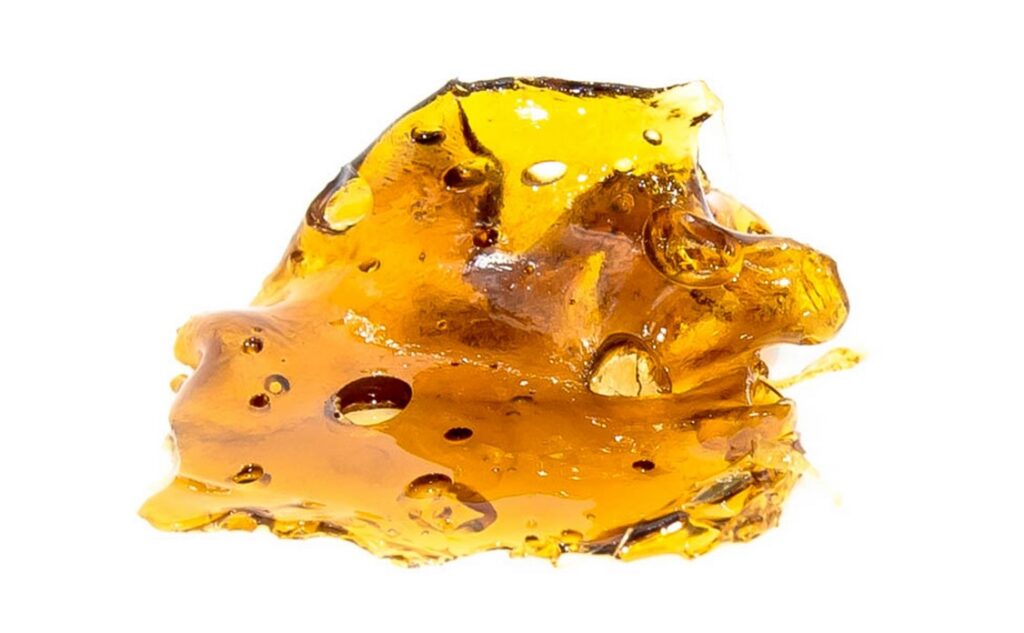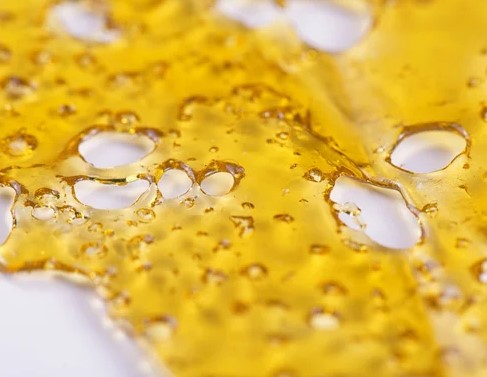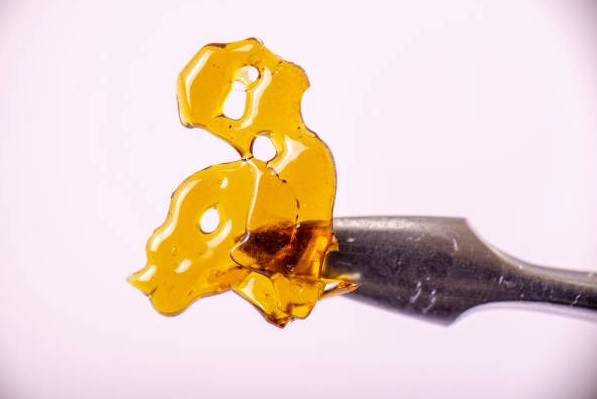THC bound to a carrier oil is extracted by butane extraction and turned into shatter. Shatter has been popular among marijuana users in recent years for its glassy, appealing texture and high THC content. Let’s look at what shatter is and how it’s produced, as well as how we evaluate it, closer.
About shatter

Shatter is a cannabis concentrate that has the appearance and feel of glass when broken, as well as a hard, brittle texture that frequently fractures or shatters. It’s usually gold or amber in color. Despite the fact that shatter is sometimes regarded to be more powerful or pure than other extracts, this isn’t always true; rather, it depends on the conditions under which it was extracted.
Shatter is usually dabbed, which entails the rapid vaporization of a specialized water pipe known as a dab rig. This glassy substance has a poor reputation for being powerful, but the potency varies depending on the plant’s source and extraction methods and equipment used. While cannabis flower’s watermark generally stays below 30% THC, shatter extracts have been observed to contain up to 80 percent to 90 percent THC.
What is CBD Shatter?
THC is the most prevalent cannabinoid found in shatter, however many concentrate producers also produce CBD shatter with a high quantity of cannabidiol (CBD) and little THC. CBD shatter is designed particularly for individuals seeking medical or therapeutic benefits from cannabis without the psychotropic effects of THC.
CBD shatter is a CBD product that may be beneficial to medical marijuana patients and other individuals interested in health and wellness since it contains a concentrated, effective dose of CBD.
History
Shatter is a relatively new variant of cannabis use that has only recently entered the scene. Hashish has been produced for millennia. Modern cannabis concentrates were perfected in the late 1990s, and shatter, as we know it today, was first created.
In 1989, D. Gold issued a second edition of his 1973 original book “Cannabis Alchemy: The Art of Modern Hashmaking,” which included the first complete description of how to make hash. Medical technology specialist Michael Stark published a second edition of his 1977 book “Marijuana Chemistry: Genetics Processing and Potency” in 1990, with a complete account on how to create hash.
In the late 1990s, Canadian cannabis producer BudderKing began marketing budder and shatter, with its items being available in dispensaries in 2003. In 2005, Cannabis Culture magazine published the procedures for creating these products. With dab rigs and water bongs shelved alongside each other in smoke shops’ shelves, a common sentiment among concentrate users was: “If it doesn’t shatter, it doesn’t matter.” It emerged as a basic component of cannabis use during the 2010s.
How to Use Shatter
Is Shatter the Same as Dabs?
Technically, yes. Shatter can be dabbed in some situations, but not all dabs are regarded as shatter. In this case, consumers would be dabbing shatter, although other forms of concentrates can also be called dabs.
To use a nail warmer, apply a small amount of concentrate to the nail with the flat end of a dabber. Put a little bit of concentrate on the nail with the flat end of the dabber. When hot nails come into touch with the substance, it will vapourize instantly. Covering allows you to collect vapor and breathe through an aperture on the other side of the device
The higher concentration of marijuana products, such as shatter, generally produces a stronger high and terpene-rich tastes and scents, especially when compared to smoking cannabis. The experience may be enhanced or decreased by having the proper dab equipment. Flavor will be influenced by the temperature of the nail at consumption moment, for example, which may have an impact on the health benefits.
Difference between shatter and wax

The terms shatter and wax are used to distinguish cannabis extracts. Shatter refers to solid, glassy cannabis concentrates, whereas waxes are softer and more flexible. The distinction between shatter and wax is mostly a question of degree of molecular agitation; the difference is primarily a cosmetic one. Because the molecules in the extract were not disturbed during processing like those in wax, shard has a glass-like appearance rather than that of wax.
The chemical makeup of shatter and wax extracts varies. To put it another way, while some shatter is typically higher in THC than wax, this isn’t always the case. The strength and chemical composition of any given extract should be determined using products from your local dispensary.
Another distinction between shatter and wax has to do with simplicity of use. Wax is softer and, in some circumstances, easier to handle using dabbing equipment such as scoops. You could have difficulties scooping and dosing the appropriate-sized dab because shatter breaks down into wildly varied fragments when shattered.
Shatter Drug vs. Marijuana
The disruption of nature by humans, as seen with the coca plant and poppy being transformed to produce cocaine and heroin, is sometimes poisonous, addicting, and less beneficial than helpful in the world of illicit drugs. Because people believe shatter is considerably more dangerous than marijuana, they have likened it to that drug.
Shatter is manufactured by chemically processing cannabis, which means it has the same psychoactive effects as marijuana.
The chemical compound that gives shatter its distinctive bitterness and stone-like structure is known as CBN. CBN, like natural cannabis, has a THC content of 20 to 60 percent. In terms of THC concentration, shatter is more powerful than normal marijuana, with levels ranging from 20 to 60%. Users of shatter drugs report a quicker onset of effects and a stronger degree of strength and intoxication — as well as additional negative side effects connected with the drug, such as psychosis, anxiety, and paranoia.
Despite the fact that medical marijuana is permitted in more than half of the United States, creating shatter is illegal in all 50 states. The community is divided on whether or not shatter is helpful or hurtful to the industry and patients. Some people feel that because to its higher potency, compared to cannabis, shatter and other hash oil concentrates are superior at relieving pain and treating various illnesses. Others claim that impurities formed during production, as well as the negative stigma surrounding BHO owing to home extractions causing explosions and fires, negate any potential advantages of having a more concentrated dose of THC.
The fact is, both shatter and cannabis can have major negative consequences for the user, and they should not be treated lightly.
What are the Side Effects of Shatter?
Although shatter and other cannabis concentrates are often high in THC, it’s important to consider the possible negative effects of using such powerful substances. Although THC has been proven to have a variety of health and medical benefits, too much of it can induce uncomfortable side effects such as anxiety and paranoia. To avoid unpleasant side effects, if you’re new to the world of cannabis extracts, start with the tiniest feasible dab and work your way up gradually.
What Happens if you Eat Shatter?
Shatter must be decarboxylated before it can be used, which is accomplished through heat. This concentrate is intended to be heated with a dab rig, e-rig, or vaporizer in order for the high concentration of active cannabinoids to decarboxylate and interact with the body. If raw shatter is consumed without first being heated, there will be no beneficial effect.
How to Use CBD Shatter
Extracts should only be handled by experts because they carry a higher risk of chemical poisoning and potential environmental threats.
To make this concentrate, as with other extracts, the plant is crushed and then applied a solvent to extract the alkaloids. The primary distinction is the post-extraction technique. Shatter is typically created through six steps including:
- Selecting a starting material.
- Packing the material column.
- Chilling the solvent.
- Passing the solvent over the material to create the solution.
- Removing the solvent from the solution with heat to promote the vaporization of the solvent.
- Chilling the solvent tank to recondense the solvent vapors.
Shatter may be found online, but it can also be made at home. Shatter is a term used to describe cannabis that has been crushed into a fine powder, whether it’s nuggets or leaves from the plant itself. During the manufacturing process, heat and pressure are used to remove the desired cannabinoids from the raw flower. Any unwanted components are then removed with a solvent-induced vacuum purge after they have been removed using a vacuum oven.
The most popular approach for creating shatter is a butane hash oil (BHO) extraction. Other solvents like liquefied petroleum gases (LPG) or ethanol might also be used. CO2-extracted shatter would not have the same texture because it would be produced with a solvent other than CO2.
Storage Considerations
Shatter may deteriorate and lose its texture, flavor, and effectiveness if kept improperly. To prevent this deterioration, it should be stored in an airtight and lightproof container at all times. It should ideally be kept in a cold place to guarantee that the concentrate remains consistent for as long as possible. Keep it free of high temperatures, moisture, oxygen, and direct sunlight to ensure that the concentrate lasts as long as possible.
Heat is your shatter opponent, so keep that in mind. It activates the cannabinoids and terpenes. This shouldn’t happen when it’s dormant in a container. Concentrate storage utensils, such as silicone containers for concentrates, are available from dispensaries, smoke shops, and many online retailers.
Why Does Shatter Turn into Sugar, Budder or Crumble?
Despite the many different types of extracts, they all go through the same manufacturing process. If procedures are not followed precisely, solutions are damaged throughout production, or shatter is kept incorrectly,
The glass-like feel of the completed product may be ruined if the first or subsequent vacuum purge is done incorrectly, producing a piece with a texture comparable to butter or sugar.
Other factors might influence the manufacturing process. If the cannabis oil is agitated, heated to high temperatures, combined with residual chemicals or moisture from the starting marijuana plant material, or if there is too much of it, it may transform into budder rather than shatter.
Concentrated Cannabis Extract
Shatter is a form of wax produced from cannabis that resembles glass. Shatter comes in a range of hues, including amber, translucent, and brittle, glass-like texture.
The translucent quality of the extract is responsible for its name. Resinous extracts produce sheets that can be broken down or “shattered” into smaller pieces like glass when shatter is created. Cannabis extracts have been used for millennia, but shatter began to gain popularity in the early 2010s, especially alongside other concentrated cannabis extracts known as dabs.
Due to their high concentration, some consumers avoid shatter and other cannabis extracts. While marijuana flower has a THC concentration of about 10-25%, shatter has been observed to contain up to 80% THC.
Shatter, a nickname given to cannabis concentrates with a high THC content, is popular among medicinal and recreational cannabis users alike since it produces effects that come on more quickly and intensely. This is especially true for those looking for pain relief or other ailments.
Shatter’s strength has generated a lot of interest, with both cannabis users and critics praising its potency. Shatter is subjected to the same rigorous testing as other cannabis products in California. Encore Laboratories offers comprehensive lab testing to guarantee that your concentrates meet state standards.
